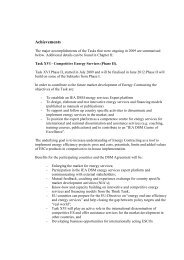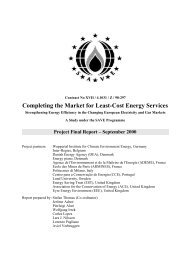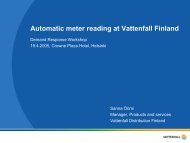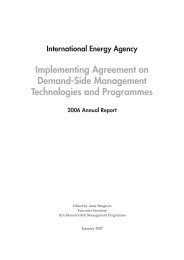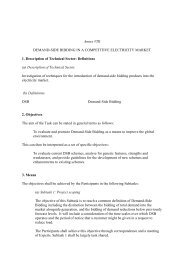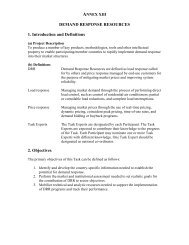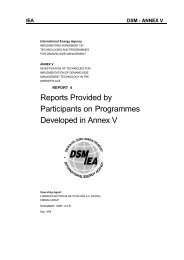Summary and conclusions - IEA Demand Side Management ...
Summary and conclusions - IEA Demand Side Management ...
Summary and conclusions - IEA Demand Side Management ...
You also want an ePaper? Increase the reach of your titles
YUMPU automatically turns print PDFs into web optimized ePapers that Google loves.
systems up to 5 kW installed capacity. In 2010 17,8 million EUR were granted under thisfunding scheme, leading to an installed capacity of over 11 MW. Each Austrian province isalso running regional PV rebate programs, aimed at overcoming the limitations of federalincentives. In most cases the support is subject to limited budgets <strong>and</strong> is linked to furtherrequirements. Generally, the regional support is only granted where the installation is notsupported by the federal feed-in tariff scheme. In 2010 the regional funding initiativesamounted to about 39,6 million EUR <strong>and</strong> helped to install a total PV capacity of about 22,6MW. In France public initiatives structured <strong>and</strong> supported the expansion of the PV market during2010: these included the feed-in tariff with a highly specific orientation towards buildingintegration, the income tax credit of 25 % of the amount of the investment in PV systemgoods (this was 50 % until 29 September 2010) up to a cap of 8 000 EUR per taxpayer (16000 EUR for a couple), the ADEME-FACE contracts for off-grid systems <strong>and</strong> variousregional <strong>and</strong> local government support measures. In order to control the development of themarket the French government set up in 2011 a new method of evolution of the purchaseobligation prices. Since March 10th, 2011, the prices of the purchase obligation arereviewed every trimester (July 1st, 2011, October 1st, 2011, January 1st, 2012, etc). Theseprices depend on the number of installations dem<strong>and</strong>ed. In the Netherl<strong>and</strong>s the market increase in 2010 compared to previous years is partly due tothe release of a backlog of grants following the start of the new subsidy scheme (SDE) in2008. Grants from previous years still remain in the pipeline. The subsidy scheme has nowbeen revised <strong>and</strong> systems below 15 kW are no longer supported. In Spain Royal Decree 1565/2010 has amended the economic regime contained in RoyalDecree 1578/2008 for photovoltaic installations in operation, putting electricity into the grid<strong>and</strong> registered in the Administrative Registry of Producers after 30 September 2008. Feed-intariffs have been amended as follows: 45 % reduction for ground-based PV installations,25 % reduction for large rooftop installations (> 20 kW), <strong>and</strong> 5 % reduction for smaller rooftopsystems. With regard to PV systems in operation, putting electricity into the grid <strong>and</strong>registered before 30 September 2008, their economic regime has also been amended bycancelling the feed-in tariff after 25 years of operation. Other amendments include adefinition of a ‹substantial change› in installations whereby the plant may become ineligibleto continue to receive the feed-in tariff set in the previous economic regime. The feed-intariff paid to Spanish PV installations was also reduced through limiting the operationalhours, via Royal Decree Law 14/2010. Operational hours are limited to 1250 hours per yearfor fixed systems, 1644 hours per year for single-axis tracking systems <strong>and</strong> 1707 hours peryear for two-axis tracking systems. Surplus generation outside these hours is purchased atregular wholesale electricity market prices. The limitation applies for the next three years;however, to compensate, the total period for which the feed-in tariff can be obtained hasbeen extended three years. In addition, a network toll has been introduced, applicable to allelectricity generation plants, with PV plants being exempt for the first three years.4.5 Smart meteringThe report analyzes the technologies, regulation, costs <strong>and</strong> benefits as well as experiences of smartmetering. It also describes the current situation of smart metering in the participating countries.Short summary of this is as follows.4.5.1 AustriaAccording to the new Electricity Act (ElWOG 2010), the Minister of Economy may introducesmart metering per decree, following a cost-benefit-analysis. The regulator may define12



